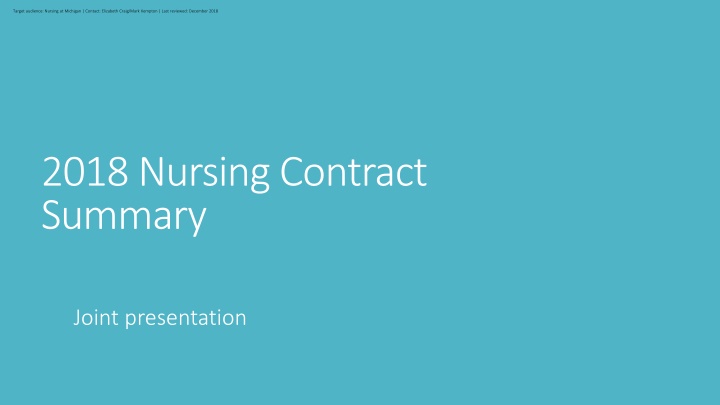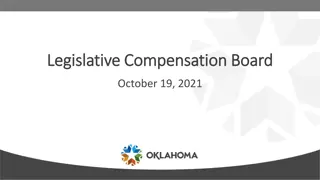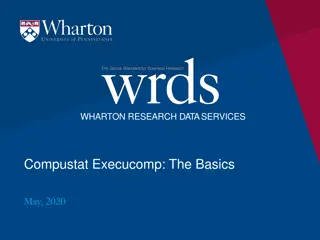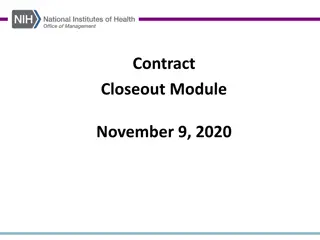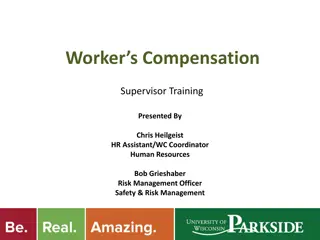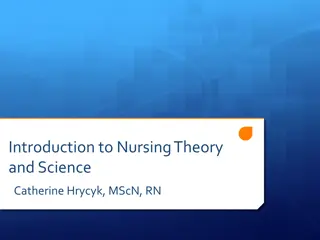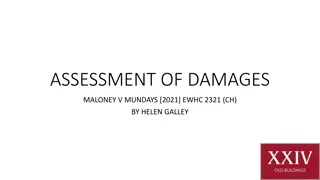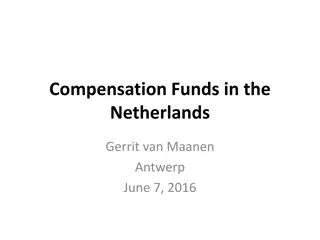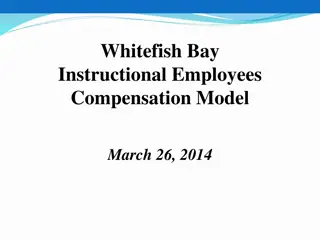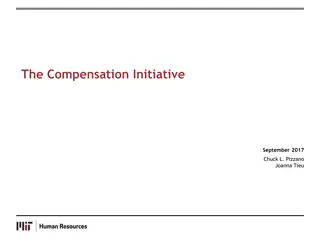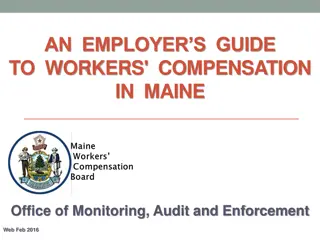Nursing Contract Summary and Compensation Changes
Nursing contract summary outlining wage adjustments, on-call rate changes, shift differentials, and removal of certain bonuses & language. Also discusses the development of guidelines for reduced staffing situations post-ratification.
Download Presentation

Please find below an Image/Link to download the presentation.
The content on the website is provided AS IS for your information and personal use only. It may not be sold, licensed, or shared on other websites without obtaining consent from the author.If you encounter any issues during the download, it is possible that the publisher has removed the file from their server.
You are allowed to download the files provided on this website for personal or commercial use, subject to the condition that they are used lawfully. All files are the property of their respective owners.
The content on the website is provided AS IS for your information and personal use only. It may not be sold, licensed, or shared on other websites without obtaining consent from the author.
E N D
Presentation Transcript
Target audience: Nursing at Michigan | Contact: Elizabeth Craig/Mark Kempton | Last reviewed: December 2018 2018 Nursing Contract Summary Joint presentation
Wages-Work is done centrally All Levels (A-F), RSAM, N4, NP4, N5 and N6 (remember that ATB s are based on Level A-C and then there are diffs applied to Level D/E and F. RSAM competent is based on Level D and then diffs are applied to other levels.) (this is an issue with disagreement between the parties and has been sent to arbitration for resolution) Year one 4% ATB Monthly effective 10/1 and biweekly 10/21 Year two 3% ATB Year three 3% ATB No retroactive pay Steps will resume as of ratification (those with Anniversary dates 7/1 thru 10/10 will step as of 10/10.) Levels B/C and C will be combined (just merging, not moving anyone forward) Year one - Lump sums of $1000 (prorated to appt fraction) will be paid to those at Step 13 and Step 14 except for those that step in that year or are merged from Level B/C to Level C. This will be paid in December. Year two and three Lump sums of $1000 (prorated to appt fraction) will be paid to those at Step 13 and Step 14 who do not step in that year. This will be paid in December of those years.
On Call changes-Effective 10/21 Level A-F $5.00/HR RSAM $5.00/HR N4 $7.50/HR NP4 $7.50/HR N6 $11.00/HR Removal of Para 171A language OR s/PACU calculation of on-call
Shift differentials-Effective 10/7 Evenings- For those employees who work For those employees who work straight evening shifts they will also receive straight evening shifts they will also receive the shift diff for scheduled PTO (including the shift diff for scheduled PTO (including incremental PTO and ATO), Jury Duty and incremental PTO and ATO), Jury Duty and Bereavement paid hours only. Bereavement paid hours only. Year 1 $2.35/hr Year 2 $2.45/hr Year 3 $2.55/hr Nights- For those employees who work For those employees who work straight straight night shifts night shifts they will also receive they will also receive the shift diff for scheduled the shift diff for scheduled PTO (including incremental PTO and ATO), incremental PTO and ATO), Jury Duty and Bereavement paid hours. Bereavement paid hours. Year 1 $3.20/hr Year 2 $3.30/hr Year 3 $3.40/hr Weekends Starts with nights on Friday through Evenings on Sunday All weekend shift hours worked $1.75/hr Quarterly and Annual Bonuses No longer exist Will pay those that are eligible as of September 30, 2018 worked will be paid at PTO (including Jury Duty and
CSR CSR quarterly bonus goes away Paid an hourly differential of $2.50, not to be calculated with an overtime rate, will be paid on hours worked and for scheduled PTO (including ATO and PTI), bereavement and Jury Duty only(effective 10/21) Post ratification- Jointly develop guidelines to be able to mandate CSR/ACNRP on and off Within 60 days of ratification, CSR/ACNRP will develop a system, reasonably accessible to employees, to identify employees on units with reduced staffing needs and provide a mechanism for voluntary alternative placement to meet unanticipated needs and reduce under appointment situations. (Para 185J old language but given timeline to complete) Holidays CSR/ACNRP will not be required to work any holidays but volunteerism is encouraged CSR/ACNRP will choose three holiday weeks (Memorial Day thru Thanksgiving) in which they will work their full appointment fraction. This will begin with the selection process in Jan 2019
RSAM Exempt status changes Immediately upon ratification All new hires and/or non-RSAM transfers placed into an RSAM position shall be considered non-exempt All new hires and/or non RSAM transfers will accrue PTO at the non-exempt accrual rates Upon expiration of this contract All employees in an RSAM position will be considered non-exempt employees and will accrue PTO at the non-exempt accrual rates.
NPs No longer will have raises based on salary program and merit There will be an adjustment of their salary increases this year to meet the 4% to their base. Some may require repayment of lumps to meet this change. There will be an internal equity review annually Work will start within 90 days of ratification to develop a Clinical Ladder for the NP s with a goal of implementation by Jan 2020
NPs other changes Change to calculation of points for placement on hiring grid On-Call increased to $7.50/hr Shift differential Day shift (starting on or after 3a and before 11a or majority of hours between 7a-3p $3.50/hr Saturday and Sunday Evening shift (starting on or after 11a and before 7p or majority of hours between 3p and 11p $4.00/hr Monday-Thursday/ $6.00/hr Friday-Sunday Night shift (starting on or after 7p and before 3a or majority of hours between 11p and 7a $4.50/hr Monday-Thursday/ $7.00/hr Friday-Sunday Holiday pay and Holiday Premium pay Will be eligible to receive holiday pay as in Para 358 and 359 and holiday premium pay as in Para 354 and 354A
NPs Other continued Professional Development Minimum of $2000 annually (for those with an appt fraction of 50% or more) for the purposes of professional development and continuing education Not less than 5 days annually, prorated to appt fraction, except that no NP will receive less than 3 days annually Evaluations Within 12 months of ratification, NP evaluations will be addressed by an NP manager. NP s will be required to complete a self-eval and participate in peer feedback on their anniversary date. All NP evaluations classified as Approaching will be reviewed by the Director of Advanced Practice Nursing Administrative time/Hospital Business No later than 5 months post ratification, all Ambulatory Care NP s will be allocated 20% administrative time of their appt fraction. Admin duties include but are not limited to documentation, returning patient calls/emails, prescriptions and checking test results. After completion of clinical admin duties and if they have admin time remaining they may use this time for scholarly activities No later than 5 months post ratification, all Inpatient NP s will receive at least 8 hours of hospital business time every 4 months. This time is to be used for scholarly activities. These activities include research, quality improvement, clinical simulation presentations
Benefits Maternity/Parental Leave Same eligibility as SPG allows for all other employees Must have delivered child 6 weeks prior to ratification (August 30th) or after to use any portion of 6 week childbirth (maternity leave) If an employee is off with childbirth as of ratification then they would be eligible for the remaining portion of their 6 weeks for childbirth time and then can use the parental leave 6 weeks if desired. Parental leave (6 weeks) can be used if a qualifying event occurred no more than 6 weeks prior to ratification (August 30th) Retirement No change to current language 1664 Health Insurance rates language Deleted going forward but agreement was reached to continue consideration of full time status for health care benefits to those eligible this year. Health Insurance copays No change to current language
PTO Interim PTO No longer exists as a process Still need to post open hours to unit for one week and then seniority decision. If no one takes then they remain open and it is first come, first serve Still can t arbitrarily close hours Increased guaranteed access from 70% to 75% (begins with PTO selection in 2019) Fixed calendar to reflect current process Feb 1-21 First round By Feb 28th repost Mar 1-14 Second round By April 1st post final
PSM Removed requirement in current contract for HR rep to join No Pay meeting An employee will be permitted to use up to two occurrences of unscheduled absences within a 12 month period resulting from the employee s own personal illness or health condition which will not count as an occurrence and will not be subject to a PSM as long as the employee provides a health providers note showing the employee was seen by a healthcare provider within 48 hours of the absence Obtaining a representative An open calendar will be maintained with scheduled blocks of available representative time and CND/Supervisors will have access in order to schedule PSM s more efficiently Group email accounts will be created for representatives to be more easily contacted PSM #2 Changed path to move to PSM#2 2 or more additional occurrences within 3 months from date of last occurrence or if employee has 4 more occurrences within 9 months after date of last occurrence
Staffing Changes to Article 13/14 Defined Staffing Model and Staffing Levels Agreed to maintain current If there are significant, long term changes (not day to day or shift to shift) the Association will be notified prior to any discussions with staff. The next step is take the data to the units WRC for discussion. If any concerns the next step would be for the CND and WRC chair to meet with the ACNO/CNO and attempt to address the concerns. A report will be presented to the staff, WRC and the Association If concerns still exist, the next step would be WRC chair requests meeting with CND, ACNO and CNO to discuss further actions. Any further unresolved concerns would be escalated to the CNE for action planning and presented to JIT-L If concerns remain there can be a written request to the UMHS board for an appeal within 10 days of the JIT-L decision and both parties will be able to present concerns and data to substantiate their concerns or need to change. A decision will be made prior to any implementation of the changes. If the event of failure to follow the implementation process the Association may file a dispute and follow the language in Article 46 and 47. current staffing levels
Staffing continued Ambulatory Care Within 120 days agreed to explore staffing benchmarks and literature with a joint committee with a goal of establishing standards and a report will be presented to JIT Staffing Guidelines Staffing guidelines document will be added as an Addendum to the Contract Current staffing ratios Understanding that the staffing levels may increase or decrease with acuity, acute changes, patient status or unanticipated volume or for time limited reasons Lunch coverage is an issue already delegated to the WRC for discussion and planning and this continues. No agreement to maintain staffing levels while lunch breaks are being given
Staffing levels guidelines grid Addendum E- Staffing Model Attachment Staffing Models are created using many different variables, including but not limited to: Staffing levels Current staffing levels guidelines (RN only) 4:1 up to 5:1 on nights 3:1 1:1, noncritical ICU patients or stepdown status 2:1 3-4:1 day shift and 4-5:1 on nights 2-3:1 2-3:1 days and nights 3-4:1 1:1, noncritical ICU patients or stepdown status 2:1 AORN guidelines-nurse in every room EC3 2:1, Resuscitation 1:1, other area 3:1, Hallways/Recliners 4:1 Other areas 3:1, Resuscitation 1:2 ASPAN guidelines 1:1 or 2:1, phase 1 & 2 depending on pts., Pre-op 3:1 ASPAN guidelines 1:1 phase 1, phase two 3:1 *Staffing levels may increase or decrease within a unit and within a shift, depending on acute changes in acuity, patient status, or unanticipated volume in unscheduled areas General Care Tele ICU Gen Care SVU 7E PICU/PTCU OR ED Children s ED Adult PACU Peds PACU Adult Pediatric *Some patients may require 1:2 ratios due to complexity of care such as ECMO, large burn admissions/resuscitations, etc. Average daily census Admissions and discharges Acuity of patient types, workload and nature of care required Any specialized qualifications/competencies required for the unit population and skill mix of nurses and support staff Effects of patient charting requirements Space, technology and equipment needed to provide care Nationally recognized evidence based standards and guidelines Modification in the numbers of staff may occur as unit populations and patient care needs/acuity changes.
Transfer/Promotion Employees with more than 7 years of seniority in the bargaining unit may arbitrate disputes over transfer/promotions where less senior people are awarded the position if there is a dispute over substantial differences in qualifications. Mediation will be a prerequisite for arbitration of any such case.
Committees Ability to appoint any BU nurses to workplace committees Will utilize a process to ensure BU nurses who are elected or appointed have the needed clinical expertise needed on committee If the nurse selected for the committee has active discipline, the CND/designee may consider discussion with the Association regarding concerns Jointly develop a process and Jointly develop a process and timeline for appointing BU nurses timeline for appointing BU nurses within 90 days of ratification. No within 90 days of ratification. No changes to membership will be changes to membership will be implemented prior to plan being implemented prior to plan being presented to JIT presented to JIT- -L L Agree to make every attempt to appoint BU nurses within 30 calendar days of request. CND s may make suggestions of possible candidates Unit-based, time limited task forces and forums created to discuss unit initiatives/concerns may be excluded from this language ( must not discuss wages, hours or working conditions) Continue to use a self nomination and election by peers process for UBC membership
Documentation- MiChart Joint committee will be created of frontline nurses and management. Will be jointly co-chaired. Will provide recommendations related to nursing documentation prior to the build and implementation of any upgrade defined as a major upgrade. Prior to any major upgrade communication must occur with affected employees. Employees will have at least 45 days to access an interactive practice environment and have the opportunity to comment. APRN s will be given 4 hours of non- clinical time during orientation to customize templates APRN s will be given the opportunity to attend the 2 day optimization training If issues arise with the EMR, efforts to address will be done in the moment if applicable. If this cannot be accomplished in the moment an explanation will occur EMR issues will be a standing JIT agenda item A time study will be done (starting in the ICU) to assess time used to document and adequate staffing If there is a major upgrade, there will be at If there is a major upgrade, there will be at least two Super Users available around the least two Super Users available around the clock for 72 hours unless the joint clock for 72 hours unless the joint committee recommends otherwise. committee recommends otherwise. Super Users will be given paid business Super Users will be given paid business time to support EMR functions per unit per time to support EMR functions per unit per month month 100 FTE s or less: no less than two hours per 100 FTE s or less: no less than two hours per unit unit > 100 FTE s: no less than 4 hours per unit > 100 FTE s: no less than 4 hours per unit
PTO Donation Program Donations may be made in no less than one hour blocks (change from requiring at least 4 hours) Recipient may receive up to six weeks (240 hours) of donated PTO, prorated to their appointment fraction Donating employee must have 40 hours remaining in their bank (change from 80 hours) Employees who are unable to use their PTO in access of the maximum accrual will have those hours placed in the PTO donation pool Donating employee may request a preference for an individual they wish to donate hours. Employees who separate employment from the University with less than 12 months of employment and cannot receive a PTO payout will have their PTO hours automatically donated to the central pool A minimum of 75% of directed donations will be allocated to the preferred recipient if they are meet the requirements of eligibility Decisions are made by the PTO Donation Committee Any remaining hours are added to the central donation pool
Tuition Support Program BSN to NP degree programs Support will be provided for all course designated as Master s level courses as provided in Para 477, 477A and 477B If the program does not differentiate the Master s level courses in the BSN to DNP program, the University will support up to a maximum of 40 credit hours. Because this support is intended to coincide with the courses that would align with a Master s degree the support is to be applied to the first 40 credit hours in the program
Professional Development A calendar will be developed and maintained centrally All units will develop and maintain Professional Development Guidelines with the input of regular staff. These guidelines must be approved by a majority vote of unit staff who are eligible to vote and voting. This is similar to what was used by your units as guidelines for accessing the MNA This is similar to what was used by your units as guidelines for accessing the MNA funds or how decisions are made about conference selection using MNA funds. funds or how decisions are made about conference selection using MNA funds. There are still limits in the contract as to what these funds can be used for (no There are still limits in the contract as to what these funds can be used for (no change). change).
Professional Development Funds Funds Level A-F and RSAM Increased $250 per FTE (was $150 per FTE)-Starts immediately By April 15th of each year, any remaining MNA Professional Development funds not allocated will be pooled into a central fund. Any Level A-F or RSAM employee may submit a request on or before June 15 of that same year to use these pooled funds for professional development A central fund will be created to provide funding for those Level A A central fund will be created to provide funding for those Level A- -F and RSAM nurses who are selected to attend regional or national meetings and conferences. Funding will who are selected to attend regional or national meetings and conferences. Funding will be based on 2.5% of number of Level A be based on 2.5% of number of Level A- -F/RSAM FTE s with $3000 per FTE. The central F/RSAM FTE s with $3000 per FTE. The central fund and its funding will be implemented by Jan 1 2019 fund and its funding will be implemented by Jan 1 2019 A joint team will be convened within 90 day to create guidelines A joint team will be convened within 90 day to create guidelines Time to attend conferences or meetings funded by this central fund will be on hospital business time regardless of day of week and will be included within appt fraction N4, N5 and N6 N4, N5 and N6 (with appointment fraction of 50% of more) N4- $1500 N5- $2000 N6- $2500 Starts immediately F and RSAM nurses
Professional Development Business Time Business time Level A-F and RSAM No less than 2 days per year which the employee can choose to use on consecutive day. The paid time will be commensurate with the hours of the professional and educational activity N4, N5 and N6 Will receive no less than 5 days each year, prorated to appointment fraction, except that no employee will receive less than 3 days
National and/or Board certifications Level A-F and RSAM nurses who voluntarily attain a national and/or board certification Reimbursement will be provided for one national and/or board certification and subsequent recertification's that align to said nurses area of practice May use up to 8 hours of business time to study for an exam for which they have registered. This time must take place onsite. This paid time comes from their allotted 2 days of business time annually for professional development. Time to take the exams will be paid as hospital business time If the nurse wishes to purchase study books or materials, they would use the funds in their allotment of Professional Development funds annually. The reimbursement will be 75% of the cost of the exam. Employee must provide verification of attainment of the certification The employer can provide additional reimbursement if desired from other funds Nurses may be recognized at the unit level through means such as pins or plaques for attainment of certifications This language does not pertain to those certifications that are mandatory by the Employer A joint workgroup will be established to review all required certifications and determine the need for any additional required certifications. This work is to be completed within 12 months from ratification
Variable Activity Designated float Language cleaned up DF nurses will be encouraged to float to their DF unit at least one shift every 6 months to maintain competencies DF nurses may choose CSR cluster as their float unit and will not be eligible for the CSR/ACNRP shift diff Units are to provide adequate resource information to float staff, including a list of mentors and a handbook (paper and online) Create an online feedback form for DF nurses to provide feedback about assignments and experience. Feedback will be reviewed by JIT-L and CND s will be given opportunity to respond to JIT-L OR s- float bonus will be paid through end of case, if applicable OR s- cases occurring after hours (on-call) will be conducted in the location best suited to the patient s needs and not counted as a float occurrence CSR/ACNRP reg employees in need of placement will have priority over an inpt employee seeking additional skills in Ambulatory Care
Variable Activity continued Multi unit positions Changed dual unit to multi unit positions Can be two or more units Still have a home unit for seniority based decisions Advanced scheduling and implementation will occur so as to avoid overtime and ATO Not meant to convert all positions to multi unit No float pay for these nurses No float pay for these nurses
Variable Activity continued During periods of low census, employees may, with employer approval, work on projects which include, but are not limited to: Education, quality initiatives, and policy revisions. Any such projects performed pursuant to this Para will be part of the nurses annual performance goals or related to UBC or CNS s identified projects, and will contain specific deliverables. Availability of non productive paid time for work on said projects may be subject to limitations, as determined by the employer.
Overtime Overtime trigger payment and thresholds will go away Trigger report will continue to exist for the purpose of reviewing excessive usage of overtime and over-appointment OA/OT report produced every two weeks with need for explanation of any OA/OT greater than 10% in that pay period ACNO/CNO will provide monthly reports to JIT regarding any units experiencing staffing concerns with an action plan. 2 months post presentation to JIT, a subsequent review will take place with JIT At the time of ratification, any special incentives that are in place will remain in effect until such time the unit has OA/OT trigger of less than 5% for 2 consecutive periods. Reminder to include hours worked to cover incremental PTO on your OA/OT log to ensure equity with canceling OA/OT shifts
Overtime Penalty Overtime penalty Upon ratification If a unit has an OA/OT trigger of 7.5% or greater for all hours worked in 3 consecutive periods (an occurrence) First occurrence $100 per RN-FTE on the unit to a maximum of $7500 Second consecutive and each consecutive occurrence thereafter $100 per RN-FTE on the unit to a maximum of $10,000 Penalty monies will be used for educational, professional, or patient care related unit needs. The WRC will develop options and a vote of the unit will determine usage If a unit has been assessed a penalty twice within a 12 month period, a meeting will be scheduled within 5 business days to discuss the situation and develop further plans
Mandatory Overtime Extraordinary Circumstances A nurse will only be required to work mandatory overtime if all of the following conditions are met Work is a consequence of an emergency situation which could not have been reasonably anticipated Emergency situation is non-recurring is not caused by or aggravated by inattention or lack of reasonable contingency planning All good faith and reasonable attempts to obtain workers during the succeeding shifts have been exhausted and there is no one to take over the assignment The nurse has the skills and expertise that are required for the work Patient care assignment requires continuity of care through completion of a case, procedure or treatment The nurse has been informed of the basis for the mandatory overtime
Overtime pay Mandatory overtime will be paid at 1.75x 1.75x the employee s rate of pay. Overtime worked related to patient care safety, such as completing patient care, procedures, tests and transport will not be considered mandatory overtime will not be considered mandatory overtime and will not qualify for mandatory overtime pay premium not qualify for mandatory overtime pay premium will Over Appointment hours worked in these patient care safety situations will be paid at 1.5x hourly rate of pay.
Overtime limits Year 1 Same as current Year 2 and 3 All units including Ambulatory Care: 4 hours OA/OT in a 4 week scheduling period. The ED will continue to have a on call limit of 4 hours in addition Exceptions to overtime limit Still exist Para 163E schedule changes that create overtime, including trades or coverage related to incremental PTO access, coverage for employees who are absent due to sick time or FMLA, and employee initiated double backs Prescheduled over appointment Hours worked related to requesting, prior to schedule being posted, holiday off and working full appointment fraction OR/PACU/Procedure areas: On call and over appointment/overtime worked as a result of traditional holiday, weekend and off shift on call systems Incidental OA/OT in all areas except OR/PACU/ Procedure areas that is less than one hour. In OR/PACU/Procedure Areas incidental OA/OT that is less than 30 minutes is not applicable to the individual limit Removed language about needing to calculate overtime pay based on 6 month period that employee has decreased their appt fraction
Overtime miscellaneous In order to assess if there is an issue with mandatory overtime data in real time will be utilized as well as submitted to the Association on a bi-weekly basis. When an unexplainable block of 4 or more hours of mandatory overtime is identified, the CND will convene an emergency staff meeting within 3 business days. The attendees at the meeting will be the CND, UMPNC rep, and any available nursing staff. A report of the meeting will be sent to the ACNO/CNO for that area. If mandatory overtime or over- appointment is used in a 4 week period, a written report on the rationale for usage will be sent to the ACNO and the Association. This report will be presented at the next JIT-L
ATO Changed process for volunteering for ATO Staff willing to float On-call, if needed. Hours of on-call will be for entire shift unless agreed upon when asked Other steps deleted so goes directly to willing to be off with either No Pay or PTO DF nurse If have not floated to their designated float unit could go to that unit prior to mandating staff off in order to maintain their competencies and skills Limit of ATO changed Make a good faith effort to limit ATO to 12 hours in a pay period (was 16 hours)
Per Diem changes Per Diem employees will have credit for 50% of their Per Diem time used as bargaining unit seniority for the purposes of selection consideration if transferring into a regular position A regular employee who retires and wishes to transition to Per Diem status will be able to do so without fulfilling the 400 hour in a calendar year requirement as long as there is no break in service. This employee will also be required to subject to all pre-employment processes in effect (including drug screen) Per Diem pay rates will be based on (N2) Framework Level C (Step 1; Steps 10-11-12) and the Per Diem RSAM will be based on (N3) RSAM-Competent (Step 12).
Level F and Mastery Plus Added Level F and Mastery Plus Master s degree required Same process to advance Pay grids Level F - $0.50 differential from Framework E Mastery Plus - $0.50 differential from Mastery
MOU: For-Cause Testing Except in cases of gross impairment added requirement to be assessed by addictionologist prior to administration of FCT If sent for FCT, employee is placed on paid administrative leave pending results Employees transferring from campus to MM positions that require handling of controlled substances will be subject to same drug testing as pre-employment condition requires Garrity rights document added to MOU The University will provide the Association as much time as possible when it anticipates FCT as long as the name is left out of the notification Modified MOU language related to reasonable suspicion and reasons to consider testing Annual joint education on substance use disorder and FCT testing process/procedure Either party may request a meeting to debrief or troubleshoot administration of the process following a specific case. Blood Borne Pathogen Testing form added to MOU An employee who is subject to criminal prosecution while eligible to return to work under the MOU terms, the University will notify the appropriate office that the nurse is eligible for continued employment.
LTD and Return to Work Within 90 days, a joint workgroup will be created to address the creation and maintenance of a centralized database of employees needing accommodation and to create a detailed return to work process from LTD for all members. Upon notification of an employee no longer qualifying for LTD, there will be a joint meeting to include Nurse Recruitment and Retention and HR to discuss conditions of return to work and options The discussion will include an assessment of the employee s abilities, skills and competencies and any additional needs or reasonable accommodations. RTW will be based on the individuals circumstances with input from unit/department leadership. Non-APRN employees on LTD will have access to certification funds to maintain mandatory certifications up to 6 years from LTD start date. Participation is voluntary and without additional pay APRN s on LTD will continue to have access to educational funds to maintain licensure, credentialing and privileging, and certifications for up to 6 years from the LTD start date. Participation is voluntary and without additional pay.
Technology and Bulletin Boards University will install bulletin boards in C & W within 18 months of ratification 90 days from ratification, JIT-L will explore ways to improve staff ability to access and utilize online registration sites for continuing education courses or other resources
Workplace Safety Flu Vaccination Communicable Disease Vaccinations Continued with ability to seek exemption based on medical or religious reasons or sign a declination form by Dec 1st. BU employees are required to present proof of immunity(Mumps, Measles, Rubella, Pertussis and Varicella included) Joint communication to recommend that all nurses receive vaccination Any employee who wishes to decline vaccination will be required to complete a jointly created evidence based education program to acknowledge the risks prior to exercising the option to decline Proof of immunity defined Medical documentation such as immunization records or equivalent, health department booklet from the state or equivalent, UMHS s EMR, medical provider documentation, or documentation from another employer If the influenza vaccination rates of eligible employees (excluding medical and religious exemptions and those on LOA) fall below 92.5%, parties will revisit and discuss these guidelines Requirements on locations to wear masks for those who do not receive a vaccination were added: If proof is not available a request will be made to have blood drawn to assess immunity status, if employee refuses they will be provided with vaccine unless medically contraindicated Within rooms where patients are physically present Patient transport elevators If blood draw or subsequent titer establishes non-immunity, the employee will have option of being provided the vaccine Corridors/hallways adjacent to patient rooms Patient homes where direct care is being provided Jointly develop, within 3 months of ratification, an evidence based program to be presented to all employees on importance of vaccinations Waiting areas with direct face to face patient contact Any location where the employee has face-to-face interaction with patients during the delivery of patient care
Chemical Exposure Within 60 days, the NHSC will implement a system for reporting of symptoms related to environmental cleaning products NHSC will be reviewing reports at least quarterly while reviewing practices and exploring alternatives to minimize risk Standing agenda item for JIT and NHSC to review incidents and actions related to potential chemical exposures If a room is closed for environmental reason, nurses in that work area must be notified of cause If an employee experiences a chemical exposure Recorded as such during visit to OHS and reported to appropriate CND CND will update employee with status of response to the report A report of such exposure will be forwarded to NHSC Units that use potentially hazardous Units that use potentially hazardous chemicals will post notice on the fire chemicals will post notice on the fire safety board and send notice to the safety board and send notice to the Association (where the chemical, Association (where the chemical, device or material is being used in the device or material is being used in the department) Needs to be done with 60 department) Needs to be done with 60 days of ratification days of ratification.
Sexual Harassment-new language Develop of education pertaining to employee rights as they relate specifically to gender identity, gender expression and transgender status. Expectation of sexual harassment training for all managers, supervisors, Associations elected officers, area reps and district reps. Creation of Persons of Confidence program Not intended to replace existing reporting systems or resources, but to provide support for employees who report sexual harassment complaints The committee will partner with experts to develop criteria for selection and annual education for individuals who fill this role The committee will determine the means for informing employees of this support system and posting relevant contact information Will be proactive in addressing and preventing in the workplace Within 90 days creating a joint steering committee dedicated to working in furtherance of creating education and resources The joint committee will be responsible for creating Mandatory education will be provided annually to all nurses and at CNO Materials in inform nurses of existing sexual complaint procedures, what to expect, available resources and employee rights Mandatory Nursing Grand Rounds on various shifts, within 12 months of ratification, will be offered on paid time Maintenance of an accessible reporting system Developing a process for informing the union of cases being initiated Develop a process where CND reviews sexual harassment policy with transfers to their unit and documents in Blue folder Address a reporting system for dealing with reports of retaliatory behavior An individual nurses choice of personal identifying pronoun will be honored by the parties. Within 90 days of convening the joint committee, development and initiation of a plan utilizing mandatory unit-based small group discussions/trainings to be conducted jointly Focus is to be on identification of sexual harassment, bystander intervention, and employee rights and process
Sexual Harassment continued An employee who reports an incident and does not feel safe remaining in his or her work area, may leave after notifying the manager. The employee will suffer no loss in pay for the remainder of that shift and will be allowed to take up to two consecutive shifts of leave from the area without loss in pay. After this point the employee must use PTO for any further time needed away from area. A complainant will not be requested to transfer based solely on the basis of making a complaint. If the complainant expressed the inability to continue to work in the area with the alleged harasser, a meeting will be held with the Association and the University to discuss options. These options may include alternative placements or assignments.
Health and Wellness resources Committed to creating and maintaining an environment that supports efforts which promote the health and well being of the nursing staff. Jointly explore way to best utilize health and wellness resources so that they are readily available to nursing staff. Post ratification JIT will conduct a needs assessment with respect to facilities and programs that are available and will facilitate a meeting with M Healthy to explore possible options offering health and wellness classes.
Neutrality Statement The University agrees that for employees covered by the CBA, membership in the Association is a matter between the employee and the Association and shall remain neutral in regard to an employee s choice to become and/or remain a member.
Parking University shall maintain a regular, dependable, and free shuttle to offsite parking sites. Maps and options available electronically. A security escort will be provided if requested. Parking lots and sheltered areas will be physically lit and well maintained to the best of ability. University will continue, in good faith, to assess possibility of adding sheltered areas where they don t currently exist. On-call employees can continue to use the On-Call/Stay Over program. Continue to have a nursing representative on the Parking Advisory Committee Any employee who can substantiate the inability to access parking will not be disciplined for tardiness related to that claim.
Concierge Care Dr. Runge is writing a letter concerning Victors Care and use of funds for community support Added language stating that no nurse would be required to work in a unit/department that is providing Victors Care
Miscellaneous Relevant Labor Market MOU Removed from contract Mission and Values Work will be done to create a tracking process for work done by nurses in the community (locally and internationally) Work jointly to develop a collaborative approach to contribute to a charity Seek a project or initiative to jointly pursue. Chosen annually Annually joint participation in a community outreach project. Filled by volunteers and on unpaid time. Emergency Reduction in Operations Clarified language to define severe weather, emergency closure and emergency reduction in operations MVN No changes to current language
Miscellaneous Association Orientation Within 4 weeks of a new BU employees orientation, the person responsible for creating their orientation calendar will plan for a 15 minute slot of time for the employee to meet with UMPNC rep. There will be a calendar maintained by UMPNC for this work. The UMPNC rep will be responsible for confirming the meeting and notifying the employee of the meeting place. Bimonthly at the APRN orientation, UMPNC will present contract orientation and provide union information. Attendance is voluntary and APRN leadership is excused from attendance
